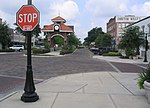The Ocoee massacre was a mass racial violence event that saw a white mob attack numerous African-American residents in the northern parts of Ocoee, Florida, a town located in Orange County near Orlando. Ocoee was the home to 255 African-American residents and 560 white residents according to the 1920 Census. The massacre took place on November 2, 1920, the day of the U.S. presidential election leaving a lasting political, but also community impact, as the 1930 census shows 1,180 whites, 11 Native Americans, and 2 African Americans (0.2%).
By most estimates, a total of 30–80 black people were killed during what has been considered the "single bloodiest day in modern American political history". One of the victims killed two white rioters in self-defense. Most African American-owned buildings and residences in northern Ocoee were burned to the ground. Other African Americans living in southern Ocoee were later killed or driven out of town by the threat of further violence being used against them. Thus, Ocoee essentially became an all-white or "sundown" town.
The attack was intended to prevent black citizens from voting. Poll taxes had been imposed as de facto disenfranchisement in Florida since the beginning of the 20th century. In Ocoee and across the state, various black organizations had been conducting voter registration drives for a year. In November 1920, Mose Norman, a prosperous African-American farmer, tried to vote, but was turned away twice after refusing to pay the poll tax on Election Day. Norman was among those working on the voter drive. Angered, he returned armed with a shotgun and threatened poll workers several times so much so that there was a warrant out for his arrest. Reports say they fired at poll workers, but were driven off.
Later that day, some white Ocoee residents were deputized by Orange County Sheriff Deputy Clyde Pounds and charged with arresting Julius "July" Perry and Mose Norman. They surrounded the home of Julius Perry, where Mose Norman was thought to have taken refuge. In the process of attempting to arrest Perry, two white men were killed and others wounded, although the perpetrators were never identified. Perry and his 19-year-old daughter, Caretha, were also wounded by gunfire. Reinforcements from Orlando and Orange County were called upon, contributing to a mob that laid waste to the African-American community in northern Ocoee and eventually lynching Perry, who was in custody at the Orange County Sheriff’s Office, shooting and taking his body to Orlando, where he was hanged from a lightpost to intimidate other black people. Norman escaped, never to be found. Hundreds of other African Americans fled the town, leaving behind their homes and possessions.
"Most of the people living in Ocoee don't even know that this happened there", said Pamela Schwartz, chief curator of the Orange County Regional History Center, which sponsored an exhibit on it. For almost a century, many descendants of survivors were not aware of the massacre that occurred in their hometown.







